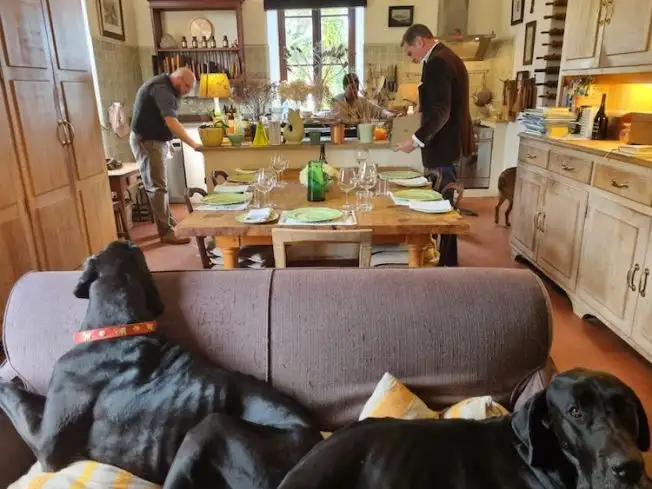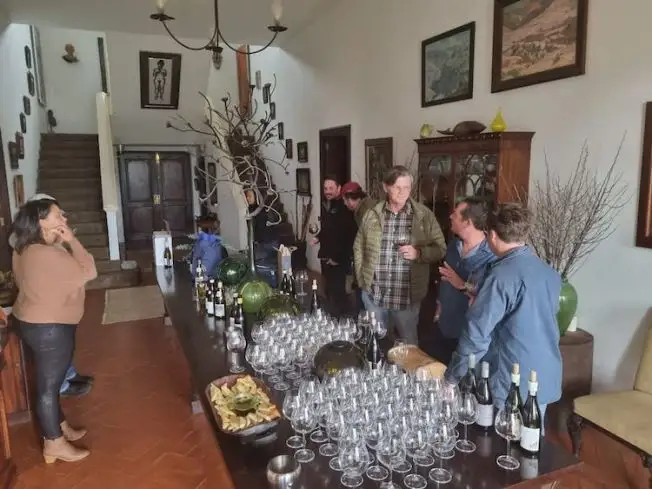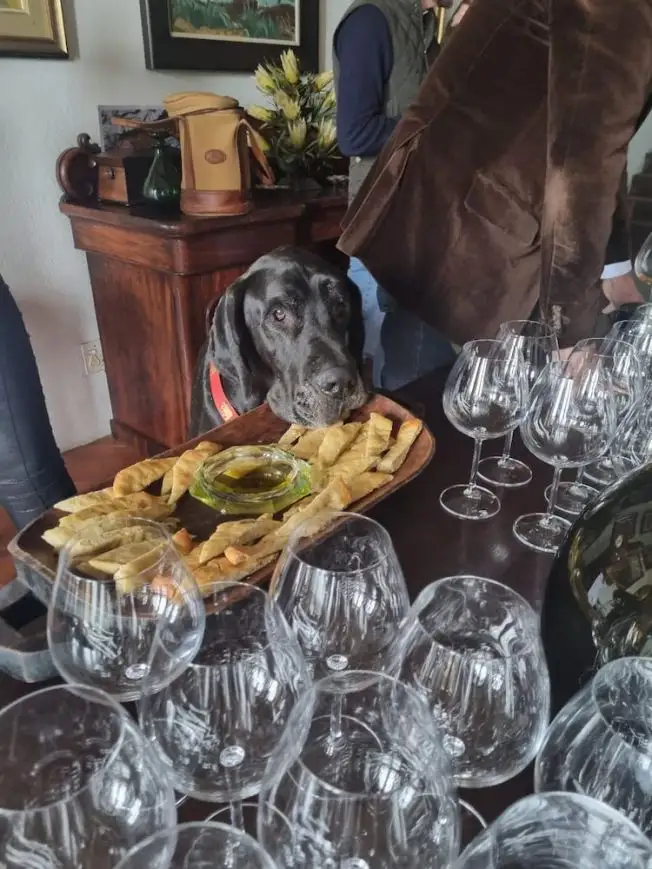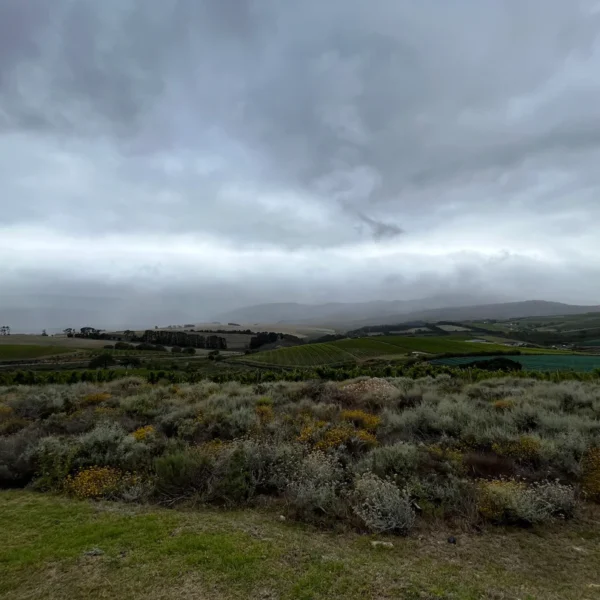These wine producers grow Pinot and Chardonnay in heaven on earth. A shorter version of this article is published by the Financial Times. See also Hemel-en-Aarde tasted.
Burgundy and Pinot Noir have been fashionable for two, possibly three, decades, but South Africa – so much more famous for hearty reds – has taken its time to identify where this delicate grape has the best chance of prospering.
It’s not as though all of the Cape’s winelands are too balmy for the early-ripening red burgundy grape. Growers tried planting it on the southernmost tip of Africa in the hinterland of Cape Agulhas and found it was just too cold and wet for the fragile, thin-skinned Pinot Noir here, so they have turned their attention to increasingly fine Sauvignon Blanc and Syrah instead.
But the country now seems to have found its sweet spot for Pinot Noir, on the south coast west of Cape Agulhas among the orchards of Elgin and, particularly, in an underpopulated valley that is known as ‘heaven on earth’, Hemel-en-Aarde in Afrikaans, in the hinterland of the whale-watching resort of Hermanus.
At the turn of the century there were just six wine producers in the valley, which stretches 15 km (9 miles) inland from the seaside villas of Hermanus. But by 2004, the year the Pinot-promoting movie Sideways was released, there were eight more, and today there are about 20. Such is the region’s reputation that quite a few of the younger, smaller producers who have revitalised the Cape wine scene are buying fruit in Hemel-en-Aarde and trucking it out to vinify elsewhere.
Reino Thiart is winemaker at the Whalehaven winery that catches the eye of any visitor to Hermanus. It’s just outside the boundary of Hemel-en-Aarde but has always sourced its grapes from there. (It owns no vineyards but is a popular tourist destination.) Thiart told me during a recent visit to the area, ‘If you want to make good Pinot [in South Africa], you have to come to Hemel. We have fantastic growers in the valley and the price of Pinot grapes has, justifiably, risen massively – to 25,000 to 30,000 rand a ton.’ As a reference point, Stellenbosch’s celebrated Cabernet Sauvignon grapes sell for about 14,000–16,000 rand per ton. Most Hemel Pinots retail for between £25 and £40 a bottle, less in South Africa itself.
Only slightly less planted in Hemel-en-Aarde is the white burgundy grape Chardonnay, whose grapes sell for between 16,000 and 22,000 rand a ton, with wines a bit cheaper than the Pinots – perhaps because, unlike Pinot Noir, there are so many other sources of exciting South African Chardonnay. I would argue, however, that Hemel is currently better at Chardonnay than Pinot Noir. Admittedly it is generally easier to make Chardonnay anywhere than Pinot, but it is taking some time to find exactly the right mix of Pinot’s many clones for each vineyard strung out along the valley, which means that many of the best-quality Pinot vines are yet to hit their mature stride.
This was true for many years of the wines of Hemel’s pioneer wine estate Hamilton Russell, founded with extraordinary vision as early as 1975 by Tim Hamilton Russell when he was chairman of ad agency J Walter Thompson in Johannesburg. It was an exceptionally brave punt to imagine that what was once poor sheep-farming country so remote that it was chosen as the site of the Cape’s leper colony would become a fine-wine region. He had to wait 14 years before he was joined in this apparently mad endeavour by his ex winemaker Peter Finlayson, who managed to persuade a Burgundian, no less, to co-found Bouchard Finlayson wine estate just a little further up the valley. This must have felt like some vindication.
But by the time Tim died in 2013, having handed over running the property to his energetic son Anthony and his wife Olive, he must have been thrilled to see that his valley had been recognised to such an extent by officialdom that it had spawned three recognisably different appellations, wards in South Africa’s intricate geographical designation system: Hemel-en-Aarde Valley, where Hamilton Russell and Bouchard Finlayson started out; Upper Hemel-en-Aarde Valley a little higher up; and Hemel-en-Aarde Ridge, furthest away from the coast and actually at the head of the Klein River Valley that extends eastwards.
All three are cooler than most South African wine regions, especially during the day when a keen breeze blows in off Walker Bay, cooled as it is by the icy Benguela current straight from Antarctica. They also see considerably more, and increasing, rain than most Cape wine regions so it is possible to manage without irrigation. During my visit there was no sign of the drought that plagued South Africa in the last years of the previous decade – although ‘load shedding’ (power cuts) were routine and hugely disruptive.
The wine industry there was already on its knees, making pitifully small returns, before the need to buy generators and diesel and/or install solar panels. Cape Town’s restaurants have had their busiest summer season for years but profits tended to have been eaten up by the fuel bill.

As soon as I arrived earlier this month for a quick pre-tasting lunch at Braemar, Anthony Hamilton Russell’s house above the winery, I was urged to recharge my laptop immediately, before the electricity went off at 2 pm. Hamilton Russell is seen above in the Braemar kitchen plugging it in.
At Braemar, the repository of a greater number of bizarre collections than I have ever encountered anywhere (rolling pins, Stone Age hand-axes unearthed on the property, the shell of every significant oyster Hamilton Russell has enjoyed mounted and captioned in a single long frame …), I had the pleasure of meeting 18 local wine producers and two of each of their wines on that Saturday afternoon. They all gathered, tasting each others’ wines round the long table in the hall (see below) and made almost as much noise as a gathering of Masters of Wine – until rugby came on the television, at which point they dispersed fairly quickly. The group are well known to be rather more cohesive than those in most other South African wine regions. As one Hemel winemaker told me, ‘if we don’t make wine they think is good enough, they soon let us know about it’.


The Bosman family have been making wine in Wellington, well inland of Hemel-en-Aarde, for eight generations and have been truly visionary, establishing, inter alia, a much-needed vine nursery and many a serious programme to improve the lives of their workers. That they decided to establish their second wine farm in Hemel-en-Aarde, in 2001, is significant. Their visitor centre there with its walking trails through the carefully conserved fynbos is popular with tourists but the wines are still made in the much hotter, drier climes of Wellington, by an all-female team.
The team will be considerably diminished by the loss of winemaker Natasha Williams, who has just been lured away to the new, Belgian-owned Hasher Family Estate. In 2021 the Belgian couple bought the old Sumaridge property, which was until very recently the source of Pinot Noir grapes for wine producers such as Whalehaven and Cap Maritime, the Hemel offshoot of Boekenhoutskloof of Franschhoek.
Williams (who made last week’s wine of the week) will bring with her her personal wine label Lelie van Saron, Saron being where she was brought up before studying winemaking in Stellenbosch and gaining experience in the Jura and at Merry Edwards in California. Her Syrah was exceptional and her wines have so far been based on fruit grown by her ex-employers Bosman, a situation she hopes will continue.
Another personal wine label named after a home village is Tesselaarsdal. It was created in 2015 by the bubbly Berene Sauls, who started out as the Hamilton Russells’ au pair and now runs logistics for their wine operation. She is determined to establish a flourishing vineyard in the little settlement of Tesselaarsdal, farmed by descendants of the nine servants and slaves of the original founder of the settlement who left the land to them. But such are the natural challenges, such as the salinity of the soil, that Sauls admits it may take another 10 years to establish the vines. For the moment her Pinot and Chardonnay fruit come from La Vierge in Hemel-en-Aarde Ridge and the wine is made by Hamilton Russell’s talented winemaker Emul Ross.
Practically all these wine producers showed me Pinots and Chardonnays, usually one of each, the exception being the characterful Bartho Eksteen who makes a seriously fine oaked Sauvignon Blanc, a style in which South Africa can rival Pessac-Léognan.
The region is not yet rivalling the best of Burgundy, but seems determined to get there.
Favourite Hemel-en-Aarde wines
The three wards abbreviated below are Hemel-en-Aarde Valley, Upper Hemel-en-Aarde Valley and Hemel-en-Aarde Ridge. UK and then US importers are cited below.
Chardonnay
Bouchard Finlayson, Missionvale Chardonnay 2021 Valley 13.1%
Seckford, Cape Ardor
Cap Maritime Chardonnay 2021 Upper 13.5%
New Generation, Vineyard Brands
Creation Wines, The Art of Chardonnay 2021 Ridge 13.5%
Bibendum, Cape Ardor
Hamilton Russell Chardonnay 2022 Valley 13.2%
Mentzendorff, Vineyard Brands
Lelie van Saron Chardonnay 2021 Upper 12.8%
Indigo, Vine Street
Newton Johnson, Family Vineyards Chardonnay 2021 Upper 13.8%
Dreyfus Ashby, Vine Street
Restless River, Ava Marie Chardonnay 2020 Upper 13%
Swig
Storm Wines, Vrede Chardonnay 2022 Valley 13.2%
Justerini & Brooks, Broadbent Selections
Tesselaarsdal Chardonnay 2022 Ridge 12.9%
Swig, Vineyard Brands, 11 more countries and via Instagram
Pinot Noir
Bouchard Finlayson, Tête de Cuvée 2019 Valley 13.9%
Seckford, Cape Ardor
Creation Wines, The Art of Pinot Noir 2021 Ridge 13.2%
Bibendum, Cape Ardor
Crystallum, Bona Fide Pinot Noir 2022 Valley 13.5%
Liberty, Skurnik
Bartho Eksteen, Fluister Pinot Noir 2021 Valley 13%
The Aycorn Shoppe (Old Coulsdon), Elephants Corner (Winston Salem, NC)
Syrah
Lelie van Saron Syrah 2021 Upper 13%
Indigo, Vine Street
Tasting notes, scores and suggested drinking dates in Hemel-en-Aarde tasted. Some international stockists on Wine-Searcher.com.


